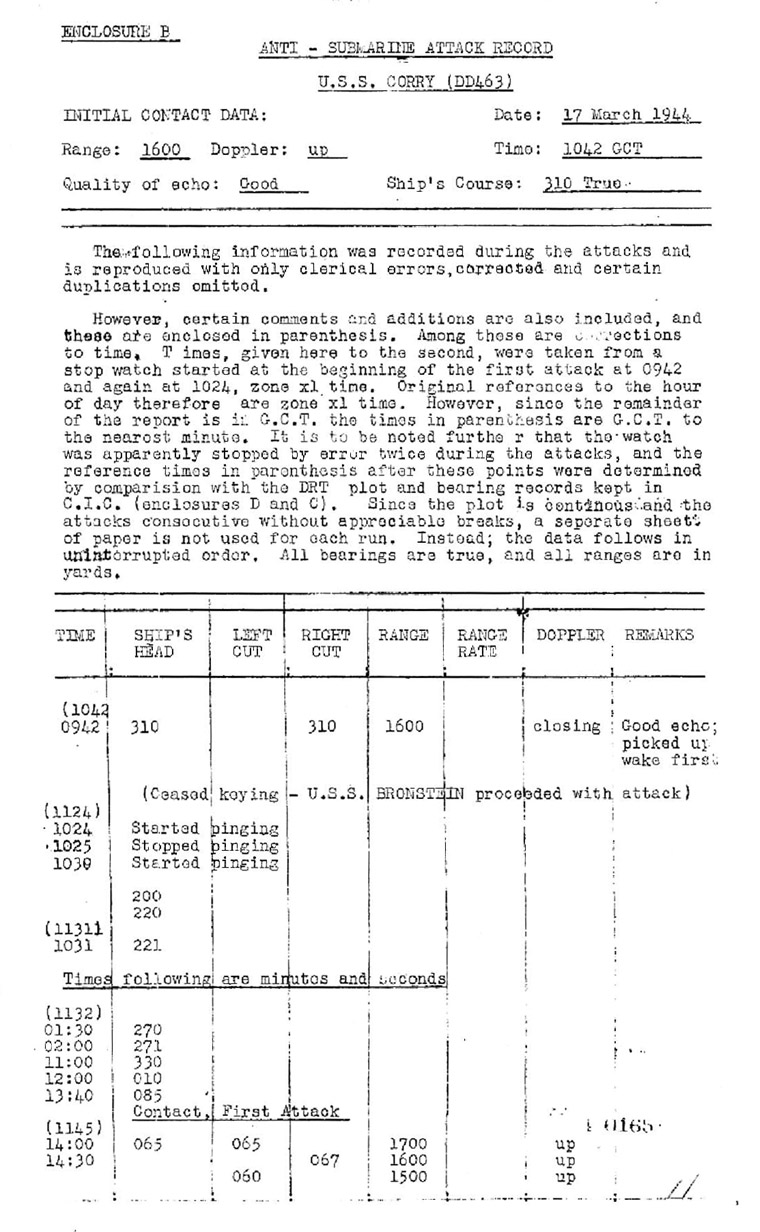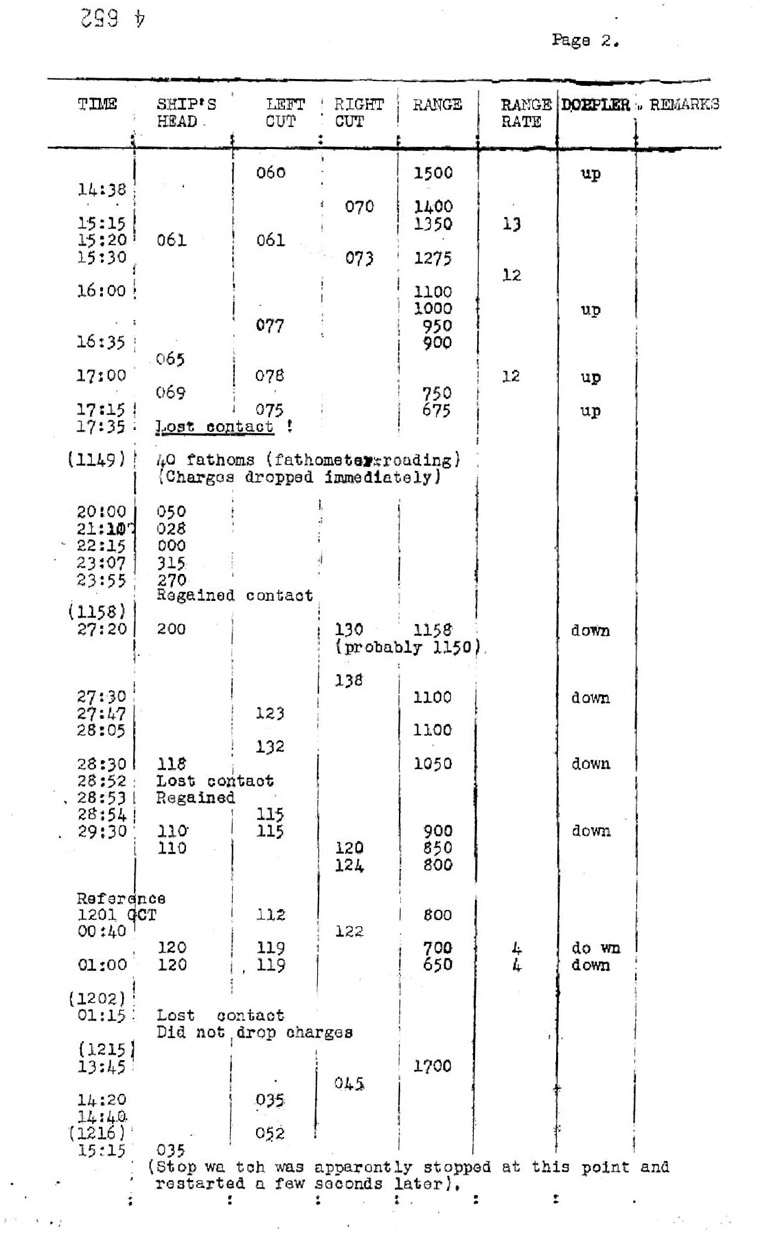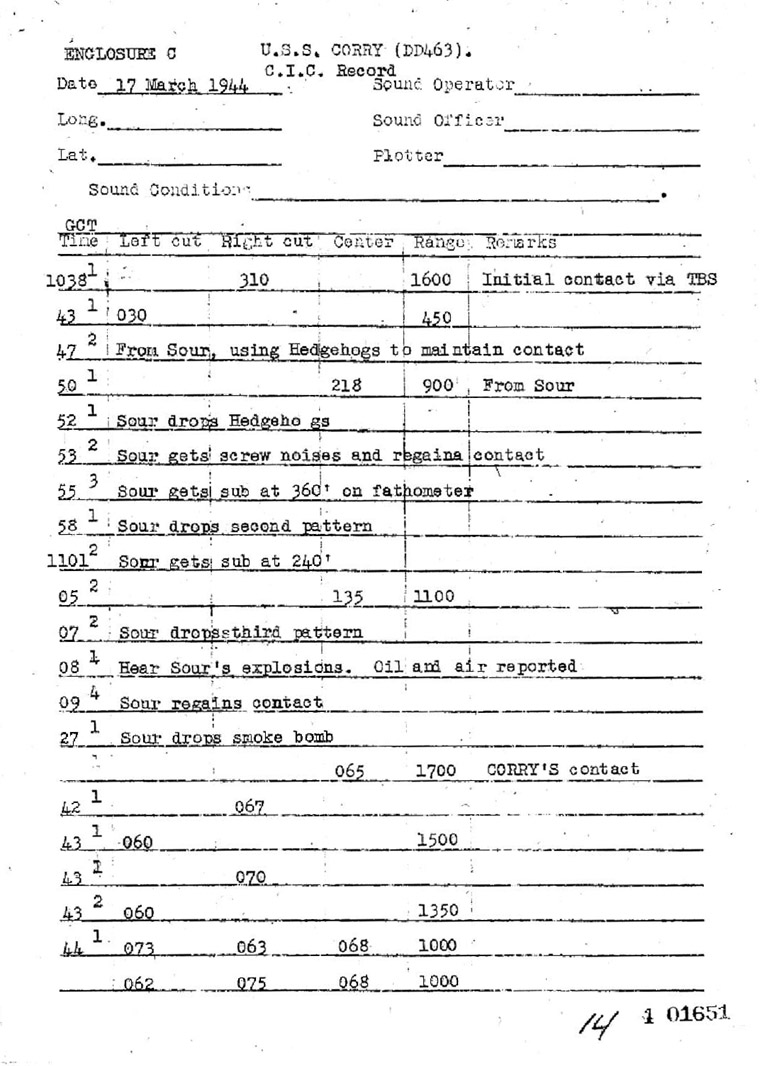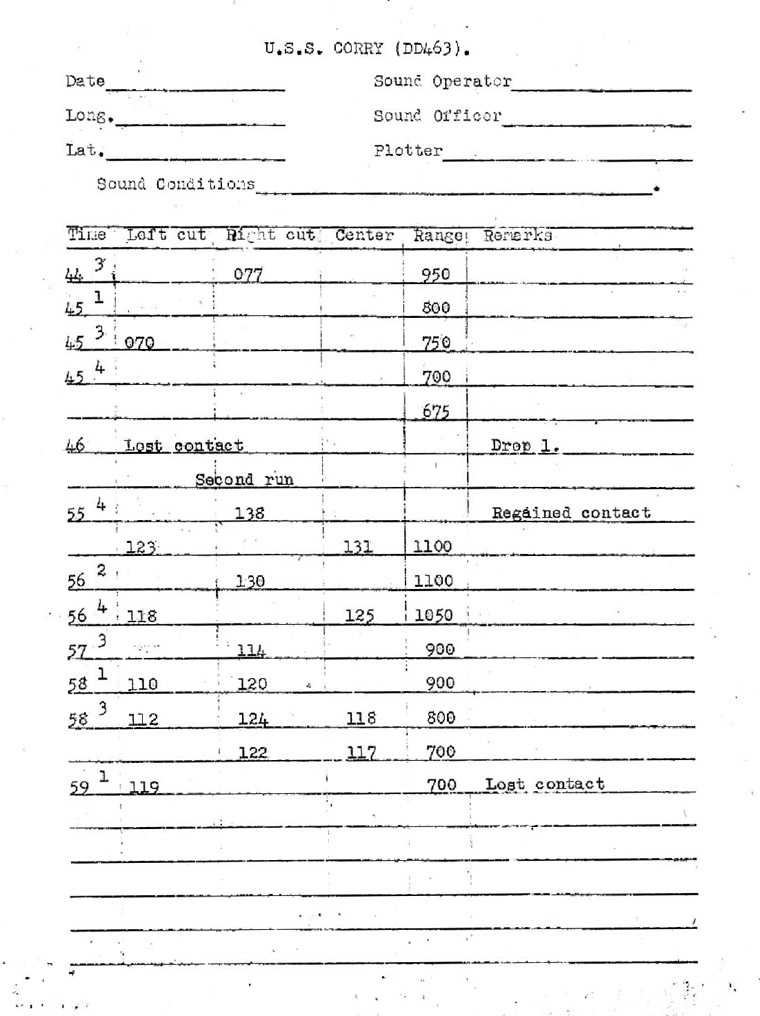|
||||||||||||||||||||||||||||||||||||||||||||
| 27 March 1944 | ||||||||||||||||||||||||||||||||||||||||||||
|
||||||||||||||||||||||||||||||||||||||||||||
| 1. In accordance with reference (a), enclosures (A), (B), (C), (D), (E), and (F) are forwarded herewith. | ||||||||||||||||||||||||||||||||||||||||||||
 |
||||||||||||||||||||||||||||||||||||||||||||
| G. D. Hoffman. | ||||||||||||||||||||||||||||||||||||||||||||
| Advance copy to: | ||||||||||||||||||||||||||||||||||||||||||||
| Cominch | ||||||||||||||||||||||||||||||||||||||||||||
| ASDevLant | ||||||||||||||||||||||||||||||||||||||||||||
| LantASWUnit | ||||||||||||||||||||||||||||||||||||||||||||
| Copy to: | ||||||||||||||||||||||||||||||||||||||||||||
| CinCLant | ||||||||||||||||||||||||||||||||||||||||||||
| - - - - - - - - - - - - - - - - - - - - - - - - - - - - - - - - - - - - - - - - - - - - - - - - - - - - - - - - - - - - | ||||||||||||||||||||||||||||||||||||||||||||
| FIRST ENDORSEMENT U.S.S. BLOCK ISLAND 0F10/Bn. | ||||||||||||||||||||||||||||||||||||||||||||
| CVE21/A16-3/A9 | ||||||||||||||||||||||||||||||||||||||||||||
| 14 April 1944 | ||||||||||||||||||||||||||||||||||||||||||||
|
||||||||||||||||||||||||||||||||||||||||||||
| 1. Forwarded. | ||||||||||||||||||||||||||||||||||||||||||||
| |
||||||||||||||||||||||||||||||||||||||||||||
| F. M. HUGES | ||||||||||||||||||||||||||||||||||||||||||||
| Copy to: | ||||||||||||||||||||||||||||||||||||||||||||
| Cinclant | ||||||||||||||||||||||||||||||||||||||||||||
| ENCLOSURE A C O N F I D E N T I A L | ||
| (NOTE) All times in this report are G.C.T. and all bearings are true. Times in enclosures C and D, are 3 minutes slow. | ||
| Planes from U.S.S. BLOCK ISLAND made contact with the submarine about 1820, 16 March 1944, about 85 miles from the Task Group. The CORRY at once set out at 28 1/2 knots on course 208. At 1923, the Carrier reported the submarine to bear 193 from the CORRY, 66 miles away and the CORRY changed course to 193 at 1924. At 2129, the ship was informed by TBL from CTG 21.16 that the best estimated position of the submarine was five miles south of her original position. On arrival at this point the CORRY attempted by means of her SC radar to rendezvous with the plane, which was still in the vicinity, but she was unable to do so. She therefore headed toward the submarine's last estimated position at 16 45' N; 30 03' W. On arriving there, the CORRY slowed to 16 knots, and at 2315, began a regular sound search, using Plan 2, F T P 219, with modifications to account for her slightly higher speed during the search. (It was considered that the last good estimate of the submarine's position was two hours old.) 0025 Radar contact interrupted the search. The pips resembled those of sea return, but they were pronounced, and since the sea, moreover, was almost glassy, they were investigated. Nothing was found, but later tracking of the submarine indicates that possibly she attempted to surface at this point. Furthermore, survivors remarked that every time they tried to come up they found either a ship or plane almost on top of them. | ||
| This search was abandoned as doubtful at 0044 and an attempt was made to continue the FTP 219 plan by lengthening each leg of the plot to counterbalance the loss of time. | ||
| At 0305, U.S.S. BLOCK ISLAND reported high frequency radio transmissions, and the CORRY changed course to 205 to investigate. Shortly thereafter she made radar contact bearing 195°T, distance 6800 yards. This was later found to be two radar decoy balloons, and on orders from the carrier, the CORRY shot them down. Shortly there afterwards, one of the planes reported visual contact with the submarine. The CORRY's SC radar picked up the plane 21 miles distant bearing 295°T. The destroyer turned west, and at 0526 on course 270, reached the spot indicated. The plane had dropped flares and sono buoys, and the CORRY began a box search around this point: At 0805 the CORRY was joined by the U.S.S. BRONSTEIN (DE189), which took position 2500 yards on the CORRY's port beam. At 1013, the CORRY sighted an oil slick and headed for it. A plane came over it and at 1205 stated that it had dropped smoke floats for its entire length and requested that the CORRY follow it. BRONSTEIN was now 200 yards to port. At 1041 the plane stated that the oil was bubbling near one of the smoke floats. Both ships came left 10°. At 1042 the CORRY and BRONSTEIN made sound contact simultaneously, the CORRY reporting a bearing of 310 and a range of 1600 yards. The first echo was wake, but it led quickly to a solid echo with a closing doppler. At this point the BRONSTEIN went in to attack, and to avoid interference, the CORRY ceased pinging. After several runs the | ||
| BRONSTEIN lost contact, and the CORRY began pinging at 1130. At 1145 contact was made at 1700 yards, bearing 065. THe echo was high, the range rate of 12 knots was greater than ship's speed (10 knots), and bearing movement was moderately fast to the right. Contact was lost at 650 yards, but twenty seconds later, at 1149 the fathometer showed a reading of 40 fathoms, and a very deep pattern of ten charges was dropped immediately. The ship was somewhat left of target bearing, and, moreover, since it was impossible to change the depth charge settings, the submarine was possibly undamaged on this run. | ||
| At 1158 contact was regained bearing 130, range 1150. The echo was low. The CORRY came left, but contact was lost at 1050 yards, whereupon the ship backed down on both engines, and for the remainder of the attack proceeded toward the submarine at varying speeds not exceeding 5 knots. | ||
| ENCLOSURE A C O N F I D E N T I A L | ||
| Contact was regained within 30 seconds, however, and the bearings showed movement to the right, the echo remaining low, and the recorder traces giving evidence of a quarter attack. At 1202 contact was lost at 650 yards. At this time the range rate was 4, but this was undependable, owing to the changes in own speed. A very good deep 10-charge pattern was set but not dropped. | ||
| At 1215 good echoes came in from 1700 yards on bearing 040. Those were followed in to 600 yards before contact was lost at 1219. The CORRY's attack speed is uncertain. | ||
| Owing to the relatively low range rate and the range of lost contact, it was necessary to assume a firing range rate and to manipulate the plotter bar of the recorder by adjusting its horizontal and vertical axes in proper proportion to make it extend to the traces. This was done with reasonable accuracy, but irregularities in ship's speed again made the range rate undependable. A deep pattern was dropped at 1222 without discoverable consequence. | ||
| Contact was regained at 1224 bearing 215 at 900 yards. The range was opened to 1150 yards and at 1226, as the CORRY prepared to come right in the direction of the contact, a periscope was reported on the starboard beam. The bridge at once ordered that charges be dropped. It was shortly afterwards decided that the periscope report was erroneous and the order to drop was rescinded. Six charges however, were already in the water. Contact was again made at 1231. The CORRY continued to come right, following the bearing movement. This time contact was retained until the echoes, both audible and visual, could no longer be distinguished from the outgoing signal. As it became evident that the target was not deep, successive orders were given to change the charge settings from deep to medium to shallow. The recorder traces, however, which at first showed promise of developing into solid traces, widened and became confused after 600 yards, and no pattern was dropped. At 1235 the fathometer gave a momentary reading of 15 fathoms. Contact was not immediately regained. | ||
| At 1252 a good echo was picked up bearing 015 at 2300 yards. The BRONSTEIN, which had made sound contact at 1251 and was preparing to take over the attack, was discovered to be on the same bearing, and the bridge ordered that pinging be stopped. At this point, C.I.C. called to the bridge that the BRONSTEIN was farther away than 2300 yards. Pinging was immediately resumed. | ||
| At 1254 as the CORRY headed approximately north, good echoes were obtained on bearing 025, distant 1900 yards. The target passed down the starboard side before the ship headed toward it, the range, in consequence, closing slightly, then opening. At 1303, with the target bearing about 090, range approximately 1650, the CORRY turned right at varying speeds, generally well under 8 knots. | ||
| The submarine about this time apparently executed a 90 turn to the left, to cross ahead of the attacking ship at right angles, and may have fishtailed in doing so. As the range closed the attack developed into a quarter chase, due to the destroyer's low speed. The DRT plot indicates that the submarine was making at least 6 knots during the last stages of the run. Doppler was low, range rate almost non-existent, and the traces were those of a quarter attack. Target angle was estimated to be about 200. A deep pattern was ordered. | ||
| The recorder traces faded out at 600 yards, and the sound officer, realizing that the recorder firing time would be in wide error because of his ship's alteration of speed during the run, called on C.I.C. to furnish firing time from the DRT track. | ||
| ENCLOSURE A C O N F I D E N T I A L | ||
| A deep pattern was dropped at 1314. The DRT plot at this instant indicated that the CORRY had overshot, but, by good fortune, the submarine made an evasive right turn directly into the charges. Contact was regained two minutes later bearing about 150, range 600. As the CORRY came slightly right to bring it on the quarter, the echoes faded out at a range of 1250, bearing 148. A moment later, the lookouts reported the submarine surfacing deep on the starboard quarter. | ||
| The U-boat's crew scrambled over the side with no apparent attempt to man the guns, and they were left well astern as the submarine's momentum carried her beyond the point of surfacing. The CORRY's five-inch guns opened fire and achieved a number of direct hits on the conning tower and hull. | ||
| The submarine, however; was already slightly down by the stern. When she broke surface, her bow protruded at an unusually steep angle above the water, and was visible some seconds before the conning tower appeared. She never completely leveled off. | ||
| The CORRY closed in, firing with all guns. The U-boat's stern began to settle. It was decided to finish her off by ramming, but as the CORRY headed toward her, the submarine's stern disappeared and her prow rose rapidly out of the water. She sank at a sharp angle several seconds later, at 1324, after which the CORRY and the BRONSTEIN proceeded to pick up survivors, of which there were 47. | ||
| Circumstances indicated that the submarine had suffered no vital injury prior to the last run, but that the final pattern had produced such serious damage that her captain decided to surface and abandon her. It is thought highly improbable that she could have remained afloat long, even had she escaped damage from surface fire. This conclusion was supported by statements of the survivors. | ||
U. S. S. CORRY (DD463) |
||
| CONFIDENTIAL | ||
| 17 March 1944. | ||
ADDENDUM TO ENCLOSURE A |
||
| Commanding Officer's and Gunnery Officer's Report of Depth Charge and Gun Attacks on U-801 on 17 March 1944. | ||
| I. Narrative. | ||
| After conducting an all night long box search for the submarine the CORRY while on the northern perimeter of search was joined by the U.S.S. BRONSTEIN (DE189). About 1041, a BLOCK ISLAND plane guided both vessels toward fresh oil appearing on the surface. Prior to this time the BRONSTEIN had been placed on port beam of CORRY in order to sweep down the oil slick path. | ||
| At 1042, both vessels made sound contact ahead simultaneously. The BRONSTEIN was directed by Commanding Officer, CORRY to attack first because his contact was announced first by TBS before CORRY's. THe BRONSTEIN fired two hedgehog pattern with no resulting explosions and then shifted to depth charges, dropping one pattern. During this time CORRY was remaining in vicinity without pinging, waiting to take over the attack. | ||
| At about 1125 the BRONSTEIN, having not had contact for a while, was directed to clear for the CORRY, who commenced searching at 1130. During the next two hours the CORRY attacked the submarine with four depth charge patterns, each containing serial 600# charges in addition to the 300#. Very slow speeds were used in order to continually cling to contact. At 1314 the final depth charge attack was made which turned out to be a humdinger according to the submarine crew, particularly those with the broken ear drums. In discussion later they maintained they couldn't stand it any longer. | ||
| At about 1319 the submarine surfaced well aft on the starboard quarter. It had been brought on the quarter after the last attack for purpose of regaining sound contact for the next depth charge attack. Right full rudder was given and the general alarm sounded. Firing was immediately commenced while in initial part of turn to the right. The starboard wing of the bridge was temporarily untenable until the ship had accomplished part of the turn. | ||
| Optical ranges and automatic level were used with initial target range 2200 yards, target speed 8, target angle 250°. Own ship's speed was building up to 28 knots. The after guns did little firing principally for the reasons that the after battery was unmasked while not manned and upon being manned was masked about half the time. Gins #1 and #2, the ready guns, performed sufficient execution to compensate for the whole battery. The submarine was holed innumerable times, each occasion being denoted by a dull red glow as a projectile entered the hull. The climatical hit being one shell which hit the base of the conning tower, blowing the works to bits. | ||
| As the range was closed and there was no indication of submergence of submarine preparations were made to ram. Word was passed "stand by to ram". Engines were stopped and back one third was rung up. However, the above was quite unnecessary because at about range 300 the sub was observed to suddenly go down by the stern and up by the bow, sinking from sight stern first in a nearly vertical position. | ||
| The water was covered with survivors who were picked up. The total 47. | ||
| II Data. | ||
| 1. 5"/38 cal. Battery. | ||
| Ammunition: 5"/38 A AC Mk. 35, Mod 6. | ||
| (a) Gun #1 | ||
| Maximum firing time: 3-1/2 minutes. | ||
| Rounds fired: 43 rounds. | ||
| Casualties: None. | ||
| CONFIDENTIAL U. S. S. CORRY (DD463) | ||
| Page 2 | ||
| II Data (Cont'd) | ||
| (b) Gun #2 | ||
| Maximum possible firing time: 3-1/2 minutes. | ||
| Rounds fired: 36 rounds. | ||
| Casualties: None. | ||
| (c) Gun #3 | ||
| Maximum possible firing time: * 2 minutes. | ||
| Rounds fired: 1 rounds. | ||
| Casualties: None. | ||
| (d) Gun #4 | ||
| Maximum possible firing time: * 2 minutes. | ||
| Rounds fired: 9 rounds. | ||
| Casualties: None. | ||
| * Time from the order to commence firing to the limiting stop bearings. | ||
| 2. 40mm Battery. | ||
| Ammunition: 40mm A.P. | ||
| (a) Starboard Mount. | ||
| Maximum possible firing time: 2-1/2 minutes. | ||
| Rounds fired: 90 rounds. | ||
| Casualties: (1) temporary loss of power in train because of personnel error. (2) Personnel deafened and burned by blast from 5" gun #3, temporarily interrupting fire and requiring replacement of trainer and right first loader. | ||
| 3. 20mm Battery. | ||
| Ammunition: 20mm H.E.T. and H.E.I. | ||
| (a) #0, 1, 3, and 5 2mm mounts. | ||
| Maximum possible firing time: 2-1/2 minutes. | ||
| Rounds fired: 184 rounds. | ||
| Casualties: None. | ||
| III Effectiveness of Fire. | ||
| (a) 5"/38 cal. gun fire was highly effective with from eight to ten direct hits on the submarine being personally observed by the Gunnery Officer. The remainder of the shells fell in an area never observed to exceed 100 yards in length or 15 yards in width; no spots in range or deflection being necessary at any time. The destructive power of the 5"/38 cal. shells was gratifying to all observers, throwing debris high into the air with every hit. The entire after part of the conning tower appeared to have been whittled away, and the after deck gun was reported as sheared off by the bursts. As the submarine began to sink by the stern, and fire was shifted to the bow, a gaping hole in the bow, about three feet long, was clearly seen by all observers. | ||
| Whether or not the submarine was sunk by gunfire, or was already sinking from depth charges, is a matter of conjecture, in so far as the crew began abandoning ship as soon as she had surfaced. There is little doubt however, that the 5"/38 cal. firing hastened the submarine's destruction and sinking. | ||
| (b) 40mm firing was seen as a whole ineffective because of the temporary loss of power in train and because of interference by 5"/38 gun #3. | ||
| (c) 20mm firing was as a whole effective against any personnel who might have tried to man their guns, particularly when the range had closed in to 1200 yards. | ||
| NOTE: All times are G.C.T. | ||




Click this text to view ASW-1 Reports for USS Corry's attacks
